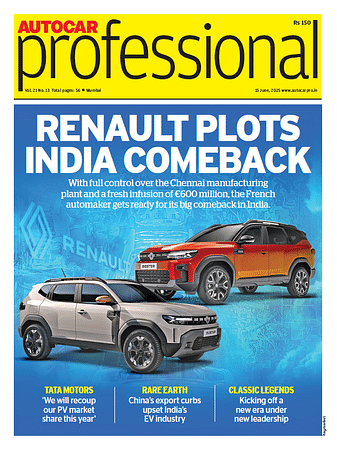Right time to phase out EV subsidies once penetration hits 20%: SIAM President
SIAM President Shailesh Chandra's comments come as the government is likely to phase out demand incentives on purchasing electric two-wheelers and three-wheelers from financial year 2027.
The right time to start phasing out the government's demand subsidy for electric vehicle buyers is once the penetration in a particular vehicle category reaches 20%, according to Shailesh Chandra, the newly elected president of the Society of Indian Automobile Manufacturers.
He is of the opinion that the government subsidies should continue till a sufficient number of people have experienced the technology in a particular vehicle category, and spread positive word-of-mouth.
“It is certainly anticipated that with growing scale and certain reductions in the cost structure of these technologies will come down to a level that subsidies can be removed,” said Chandra, who is also the Managing Director of Tata Motors Passenger Vehicles and Tata Passenger Electric Mobility.
He noted that a reduction in the cost of cells, localisation, and growing scale, are bringing down the cost of electric vehicles. Even though personal electric cars did not get a demand subsidy earlier as well, Chandra said the price of electric cars is coming down, pretty close to ICE vehicles.
“Once the penetration hits about 20%, is the right time to start lowering the subsidies,” he added.
The SIAM President’s comments come as the government is likely to phase out demand incentives on purchasing electric two-wheelers and three-wheelers from financial year 2027. Currently, the demand incentives for electric vehicles are given under the PM E-Drive scheme that was launched on October 1.
The PM E-Drive continues with the same subsidy level as given in the EMPS, for electric two-wheelers and three-wheelers but in its second year, the subsidies per vehicle for these two segments will be halved. The subsidies were also reduced in EMPS, compared with the FAME II scheme. Meanwhile, the government has included electric trucks and ambulances in the new subsidy scheme.
"It Is just empirical, given what we have seen in countries where EVs are seen as success. Typically, once you hit that kind of penetration, you start taking away the subsidy. For instance, China. Because then one out of five people is buying an EV and then spreads positive word of mouth and influences the rest of the people. Possibly that might be the inflection point," Chandra explained.
Electric passenger cars for the fleet were earlier included in the government’s FAME 1 and FAME 2 schemes, while the EMPS and PM E-Drive did not include the segment. Private electric cars never received any demand subsidy.
When asked about the exclusion of electric cars from the PM E-Drive scheme, Chandra said the lack of adequate charging infrastructure is the major barrier to electric vehicle adoption in the segment and PM E-Drive's focus on the passenger vehicle charging infrastructure will lead way for further adoption.
RELATED ARTICLES
BMW Group India Posts Record H1 2025 Sales with 10% Growth
Vikram Pawah, President and CEO of BMW Group India, stated that the company achieved 10% growth despite market challenge...
Matter Aera 5000+ Launched at ₹1.93 Lakh, India’s First Geared Electric Motorcycle
As the festive season nears, MATTER expands into the capital with its AERA electric motorcycle, featuring a 4-speed manu...
Nissan Expands CNG Retrofitment for Magnite to Six Additional States
CNG retrofitment kit now available across 13 states with Phase 3 preparations underway.





 14 Oct 2024
14 Oct 2024
 4831 Views
4831 Views





 Arunima Pal
Arunima Pal


 Sarthak Mahajan
Sarthak Mahajan

 Shruti Shiraguppi
Shruti Shiraguppi

